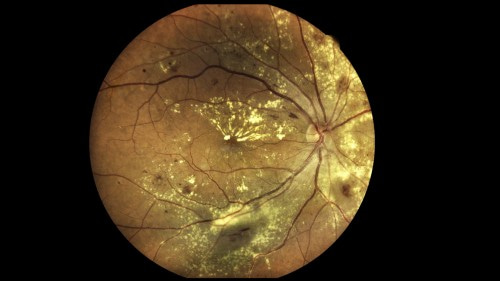Macular degeneration Collection - Scientific Reports
Published in General & Internal Medicine and Public Health

Explore the Research

Macular degeneration
This Collection will present primary research that explores the causes and mechanisms of any form of macular degeneration or highlights new potential…
About this Collection
Macular degeneration (MD) is characterised by the progressive breakdown of the macula, the portion of the retina responsible for sharp, central vision, leading to visual distortion or loss.
Age-related MD occurs largely in individuals over the age of 50 and takes two forms. The most common is termed dry or non-neovascular MD and is characterised by the gradual build-up of fat deposits known as drusen. Less common is wet or vascular MD, characterised by the rapid growth of abnormal blood vessels. Approximately 10-15% of individuals with dry MD go on to develop wet MD. The causes of MD have not been fully elucidated, though it is associated with ageing, poor cardiovascular health and genetic factors, with women at higher risk than men.
Why is this Collection important?
"Macular degeneration is a leading cause of vision loss worldwide, profoundly affecting patients’ quality of life and independence. This topic is highly relevant as it bridges fundamental mechanisms with clinical innovation in imaging and therapy. We are particularly excited about this collection because it fosters interdisciplinary research that could redefine how we understand and treat retinal aging and degeneration. The collection has the potential to inspire new therapeutic strategies and translational breakthroughs. Researchers should submit to this collection to contribute to advancing evidence-based, mechanism-driven progress in vision science."
- Dr. Junyeop Lee, Guest Editor
"Rapid advances in biomarkers, large datasets and real-world validation are improving AMD outcomes; this Collection will catalyse that progress."
- Dr. Matt Trinh, Guest Editor
Contribution highlights
Nonexudative macular neovascularization (ne-MNV) is a condition where new blood vessels grow in the eye without causing fluid leakage. This study by Anna-Maria Haas and colleagues explores how often ne-MNV turns into a more severe form that leaks fluid, which is a concern for patients with age-related macular degeneration (AMD). The researchers used advanced imaging techniques, Optical Coherence Tomography (OCT) and Angiography (OCTA), to study patients with ne-MNV. They focused on identifying features in the eye that might predict this progression.
In this retrospective study, they examined patients with ne-MNV in one eye and tracked how many developed fluid leakage over time. They found that a specific feature called SIRE (shallow, irregular RPE elevation) was linked to a higher risk of progression. About 15% of the patients developed fluid leakage, usually within the first year. The study suggests that regular monitoring of patients with ne-MNV, especially those with SIRE, is crucial. This research helps in understanding and managing the risk of progression in AMD, potentially guiding future treatments.
Age-related macular degeneration (AMD) is a common eye disease in older adults that leads to vision loss. Scientists expect the number of people with AMD to increase significantly. This study by Maria Hernandez and colleagues explores how different forms of a protein called C-reactive protein (CRP) affect AMD. CRP can exist in two forms: pentameric CRP (pCRP), which is soluble, and monomeric CRP (mCRP), which is insoluble. The researchers used a mouse model to study how these forms of CRP influence choroidal neovascularization (CNV), a process involved in AMD. They injected mice with CRP and observed the effects on CNV areas. They found that mCRP, but not pCRP, increased inflammation and edema (swelling) in the eye. The study also showed that pCRP can convert into mCRP in inflamed eye tissues. These findings suggest that mCRP plays a significant role in AMD progression. Future research could lead to new treatments targeting CRP to manage AMD.
Age-related macular degeneration (AMD) is a leading cause of vision loss, affecting the ability to see in low light and adapt to darkness. This study by Jan Henrik Terheyden and colleagues explores how well two questionnaires measure vision-related quality of life (QoL) in people with intermediate AMD (iAMD). The researchers compared the National Eye Institute Visual Function Questionnaire (NEI VFQ) and the Vision Impairment in Low Luminance (VILL) questionnaire. They tested these tools on a group of iAMD patients in Melbourne, Australia, using methods like eye exams and patient surveys. The VILL questionnaire focuses on vision challenges in low light, while the NEI VFQ is more general. Results showed that the VILL is better at capturing specific vision difficulties without reaching a "ceiling effect," where scores can't show further improvement. The study suggests that the VILL questionnaire could be more effective for future AMD research and treatment evaluations, as it provides more detailed insights into patients' vision-related QoL.
Anti-vascular endothelial growth factor (anti-VEGF) drugs have greatly improved the treatment of neovascular age-related macular degeneration (nAMD), a condition that affects vision. Faricimab is a new drug that blocks both VEGF-A and angiopoietin-2, and it has shown promise in treating nAMD. This study by Misa Masaoka and colleagues looked at patients who switched from the drug aflibercept to faricimab during their ongoing treatment for nAMD. The researchers wanted to see how effective faricimab was compared to aflibercept in the short term.
The study was retrospective, meaning it looked back at existing medical records. It included patients who had previously been treated with aflibercept and then switched to faricimab. The researchers compared the effects of a single injection of each drug on visual acuity (sharpness of vision) and fluid in the eye over three months. They found that faricimab was more effective at reducing fluid in the eye than aflibercept, although there was no significant change in visual acuity with either drug. The study suggests that faricimab may allow for longer intervals between treatments, reducing the burden on patients. However, more research is needed to confirm these findings and explore the long-term benefits of faricimab.
Age-related macular degeneration (AMD) is a leading cause of vision loss worldwide, affecting daily activities and quality of life. Current treatments mainly target late-stage AMD, but early stages also impact vision. The study by Jan Henrik Terheyden and colleagues explores how vision-related quality of life in AMD patients is linked to visual function in both eyes. They used the Vision Impairment in Low Luminance (VILL) questionnaire, which measures difficulties in low-light conditions, to assess quality of life. The MACUSTAR study, conducted across Europe, involved participants with intermediate AMD. Researchers collected data on visual function and quality of life using standardized methods. They found that visual function in both eyes significantly affects quality of life, especially in intermediate AMD. Contrast sensitivity (the ability to distinguish objects from their background) was a key factor. The study supports using the VILL questionnaire in clinical trials to better understand AMD's impact on daily life. Future research could improve AMD treatments and patient care.
Who is involved?
Guest Editors:
- Juan Gallo, Austral University, Buenos Aires, Argentina
- Junyeop Lee, University of Ulsan, College of Medicine, Seoul, South Korea
- Masahiro Miura, Tokyo Medical University, Ibaraki, Japan
- Xinhua Shu, Glasgow Caledonian University, Glasgow, United Kingdom
- Matt Trinh, University of New South Wales, Sydney, Australia
- Kenji Yamashiro, Kochi University, Nankoku, Japan
Internal Team:
- In-House Editor: Shelby Bollen, Scientific Reports, UK
- Commissioning Editor: Sophie Gray, Fully OA Brands, Springer Nature, UK
- Managing Editor: Libby Symons, Fully OA Brands, Springer Nature, UK
How can I submit my paper to a Collection?
Visit the Scientific Reports website to explore all Collections and learn how to submit your article.
Follow the Topic
-
Scientific Reports

An open access journal publishing original research from across all areas of the natural sciences, psychology, medicine and engineering.
-
A Collection of original research articles that explore the causes and mechanisms of any form of macular degeneration or highlights new potential diagnostic or treatment options to slow progression or aid in prevention of the condition.
Related Collections
With Collections, you can get published faster and increase your visibility.
Obesity
Publishing Model: Hybrid
Deadline: Apr 24, 2026
Reproductive Health
Publishing Model: Hybrid
Deadline: Mar 30, 2026





Please sign in or register for FREE
If you are a registered user on Research Communities by Springer Nature, please sign in